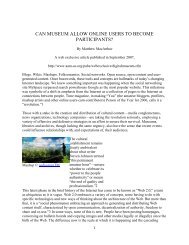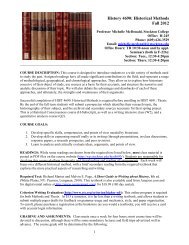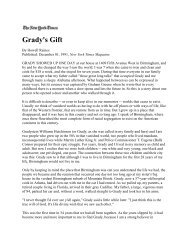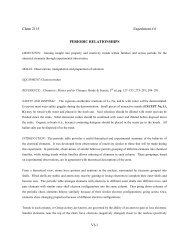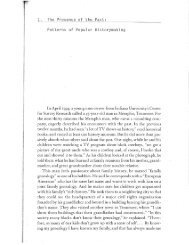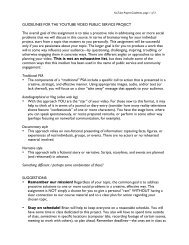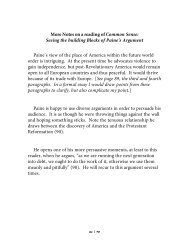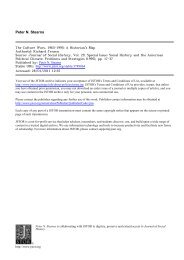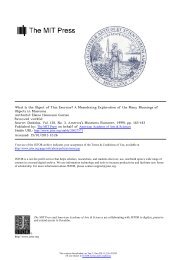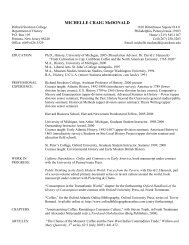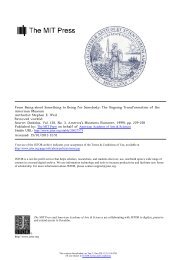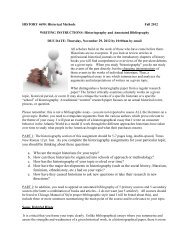Domesticating Barbie - Richard Stockton College Word Press ...
Domesticating Barbie - Richard Stockton College Word Press ...
Domesticating Barbie - Richard Stockton College Word Press ...
Create successful ePaper yourself
Turn your PDF publications into a flip-book with our unique Google optimized e-Paper software.
244 Pearson and Mullins<br />
<strong>Barbie</strong>'s new, slimmer friends gave a nod to current fashions and shifting<br />
bodily ideals. Nevertheless, Jacqueline Urla and Alan Swedlund's (1995) anthro<br />
pometric study of <strong>Barbie</strong>'s bodily dimensions reveals empirically inconsequential<br />
change in the doll's fundamental proportions over 40 years. Despite Mattel's per<br />
sistent announcements about changes in <strong>Barbie</strong>'s body (e.g., Borger, 1997, p. 40),<br />
Urla and Swedlund's measurements of a series of <strong>Barbie</strong>s produced since 1959<br />
show that <strong>Barbie</strong>'s proportions have never changed in any appreciable way. An<br />
anthropometric study of <strong>Barbie</strong>s by Kevin Norton and co-workers (1996) confirms<br />
Urla and Swedlund's conclusions: Norton et al. found that the probability that a<br />
life-size woman would have <strong>Barbie</strong>'s proportions was less than 1 in 100,000. Over<br />
a few years leading up to the Mod era, several relatively cosmetic bodily transfor<br />
mations occurred: bendable legs (1964), different-toned vinyl (1966 or 1967), a<br />
twist waist (1967), and an almost totally new face (1967). All that remained of the<br />
"old" <strong>Barbie</strong> by 1967 was her unmistakable proportions and coy, side-glancing<br />
blue eyes. Mattel may have retained <strong>Barbie</strong>'s figure so consumers would not be<br />
compelled to buy a completely new wardrobe, but they had no such compunction<br />
about Ken's body. Ken disappeared briefly in 1967, but he returned in 1968 with a<br />
physique so beefed-up he could no longer fit into his earlier outfits (cf. Mandeville,<br />
1990b) (Fig. 8).<br />
New Mod fashions ceased linking their "educational" role to a specific social<br />
space or activity. For instance, it had been obvious where to wear "Sorority Meet<br />
ing" and "Movie Date," fashions which linked a<br />
particular social space with a set of<br />
disciplinary behaviors. In contrast, there was no obvious space to sport outfits like<br />
the abstract green and orange "Two-Way Tiger" or the multicolored "Sunflower"<br />
dress with snake bracelets and oversized drop earrings (Blitman, 1996, pp. 9,<br />
148). Lord (1994, p. 62) argues that Mattel ceased linking outfit names to specific<br />
activities to evade facing what teenagers were<br />
actually up to in the late 1960s:<br />
"It was as if Mattel didn't dare admit where a real college student might wear<br />
such clothes?to march in Washington against the war, to drop acid at a Jefferson<br />
Airplane concert, or to light up a joint while occupying the president's office at<br />
Columbia University."<br />
As Lord suggests, Mattel likely was reluctant to imbue <strong>Barbie</strong> with a hint of<br />
sociopoiitics in the late-1960s. Nevertheless, this effort to distance <strong>Barbie</strong> from<br />
social and political consciousness was nothing new. After all, Mattel had made it<br />
through the early sixties without any "Beatnik Coffeehouse" or "Desegregation<br />
Riot" outfits, preferring to imagine <strong>Barbie</strong> at a staid "Lunch on the Terrace" or<br />
apolitical "Music Center Matinee" (Fig. 9). <strong>Barbie</strong> was a target of politicized<br />
discourses from the outset, but Mattel always has resisted conceding that the doll<br />
itself has any political import. It would be naive to suggest that a company as shrewd<br />
and sensitive to consumer perception as Mattel simply ignored public critique and<br />
late-1960s social unrest. In 1970, a modest but symptomatic reflection of shifting<br />
sentiments came at the Women's Strike for Equality when a young girl raised a sign<br />
reading "I AM NOT A BARBIE DOLL" (Faludi, 1991, p. xxiii). Mattel executives<br />
This content downloaded on Tue, 15 Jan 2013 10:45:42 AM<br />
All use subject to JSTOR Terms and Conditions



